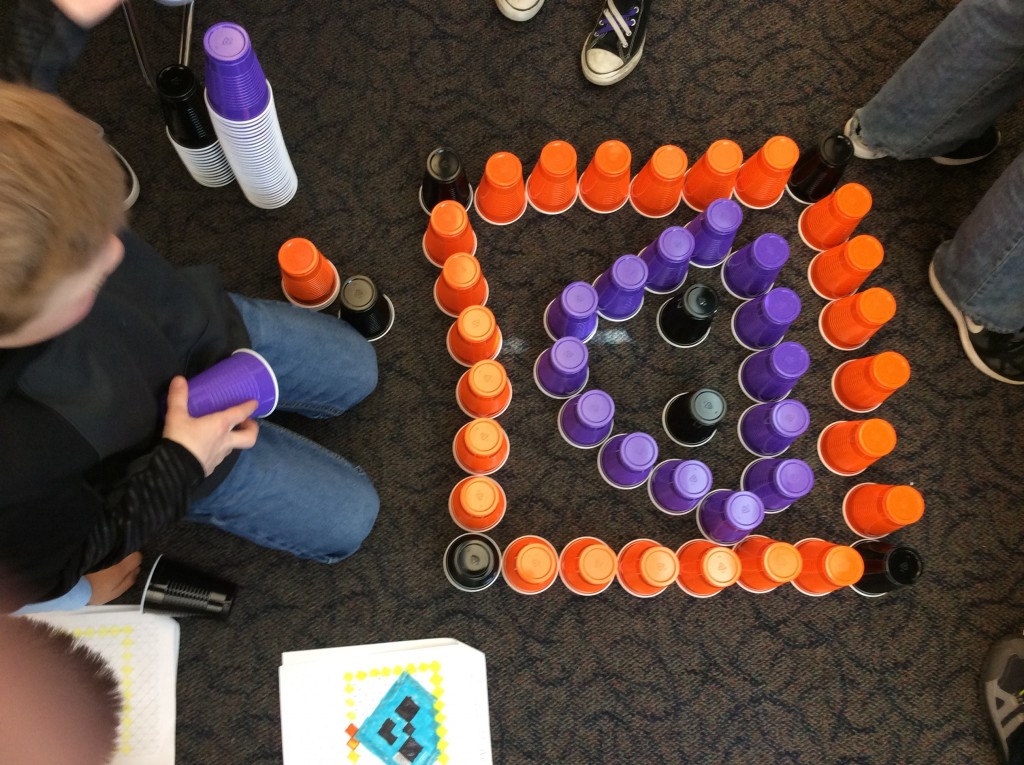Area and Perimeter Street Art: The Process
4 Min Read • Project Based Learning
A few weeks ago, my students and I embarked upon a new Arts integrated math project. I had found that it was a challenge to help students master rigorous area and perimeter concepts like Street Art, because the work that we were doing was not authentic enough– they weren’t retaining it. (Read about it here.) Enter our “cups” project, as my students would call it. This has been a learning experience for all of us, and we are still in the thick of it.
What We Did:
After sharing my idea with the students and showing pictures of chain link cup art installations, students took some time on their own to play around with drawing pixelated designs. Since we are creating a design out of cups in a chain link fence, I provided them with axonometric graph paper. For some, this was an easy task. Many students immediately thought of Minecraft and started to shade their pixels. Others had a specific design in mind, and they wanted to figure out how to create it.
After the initial struggle, I shared the app Pixelish, which allowed us to take a picture of an item and pixelate it. While I thought this app would be perfect for the project, all of my students ended up creating something original (and simple) instead of using it. I think it would be a very helpful tool for older students creating a large mosaic of a photograph.
After students had generated a few ideas, I surveyed them to find out their thoughts on partners. Students had the option to work alone, or they could double their amount of cups by joining forces with a partner. When I first shared the idea for our project, I sent home a letter asking for cup donations. (Next year, I plan to use Donorschoose.com for this, because depending on the donations, it can get expensive.) I met with students based on their survey results, we solidified our partner groups and design ideas, and we were ready to officially begin.
How We Did Street Art:
Our first step was for students to create an official design. We estimated the number of cups each person would be allotted to give students their design parameters. Early finishers were put on cup duty. Their task was to count the exact amount cups that had been donated, and divide this total by the number of students in the class. We shared this cup per student total with the class so that they could revise designs if necessary. Originally, I had planned to have student groups submit their color requests, but because of the variety of colors we had, I decided to have groups take turns choosing cups 10 at a time.
 I wish I had a video of this process — it was awesome, yet hilarious at the same time. As I called each name, that student was able to choose 10 cups to take back to their group. The students were SO serious about choosing when it was their turn. As they saw colors disappear they would huddle, quickly revise plans, decide on a new choice, and the next group member would scoop them up on his or her next turn. Student groups were shouting to the group representative as if it was a game show.
I wish I had a video of this process — it was awesome, yet hilarious at the same time. As I called each name, that student was able to choose 10 cups to take back to their group. The students were SO serious about choosing when it was their turn. As they saw colors disappear they would huddle, quickly revise plans, decide on a new choice, and the next group member would scoop them up on his or her next turn. Student groups were shouting to the group representative as if it was a game show.

Our next step was to try to create the design on grid paper with the cups. Each group worked and revised until they were satisfied. Some groups couldn’t figure out how to replicate the design at all, and decided to create something brand new. Others tweaked their original design slightly. Either way, the amount of teamwork and flexible, creative thinking it took was more than I could have anticipated. Once students were pleased with their designs, I took a picture of each, printed them, and passed them to the students. Their next task was to make sure that the design that they created was precisely on their grid paper, otherwise, the installation wouldn’t work.

Our final step is to place the cups in the fence and then dive into the mathematical computations. Originally, I wanted the math to drive the street art, but it turns out the opposite happened. I wanted to control the mathematical area that the students had to work with, but I found in the end that their designs were much more creative without my parameters, and students were free to discover even more ways to show calculations. The final touch on our street art installation will be laminated posters of student work showing the calculations of area and measurements and calculations of the perimeter. It will also include the title of the artwork and an artists’ statement.

Although this project has evolved since my original idea, I can definitely say that I have achieved my goal – my students will never forget how to calculate area and perimeter of composite shapes. (In addition, they will remember math class anytime they see a party cup…)
Find student directions and a donation letter for parents here: AreaPerimeterFenceAr



